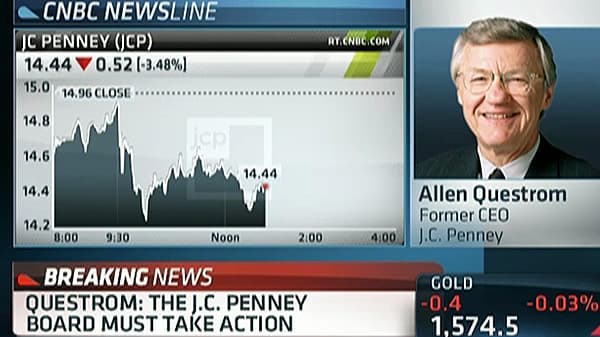Ron Johnson's cheering section must be working overtime these days to now credit him for reinventing the definition of corporate performance.
When the Dow has been setting new records on a daily basis, JC Penney stock limps along. Major shareholder Vornado Realty Trust dumped their shares below market value, and former chief executive Allen Questrom publicly called for Penney's board to remove Johnson.
The retailer also announced they would terminate 2,200 more employees, and that they would suspend selling Martha Stewart-designed products Macy's claimed were exclusive to them. Some five months later, how does this dose of reality compare to fawning predictions about Johnson's "compelling vision" and uncanny abilities?
(Read More: JC Penney Fires 2,200 as Retailer's Woes Continue: Report)
Turnarounds are hard for any size organization. But smaller companies — the backbone of the US economy — have even less margin for error than JC Penney does. Therefore, it is essential smaller and mid-size business leaders realize certain truths well understood by anyone who has ever participated in a successful business turnaround:
1. Company leadership has to (re)build a high performance culture by first stabilizing the organization. Introducing radical change, and expecting a beaten team to rally behind a heroic executive is no way to effect a turnaround. Successful turnarounds require company-wide efforts. And anything short of tireless efforts to fortify staff, identify and play to existing strengths while raising acceptable performance standards, will prove insufficient.
These rules apply in any business, but small/mid-sized businesses must pay extra special attention to visible leadership's impact because there are far fewer layers and buffers. Employees working for a struggling company are scared and when they work in close proximity to its leaders they are extremely sensitive to every cue, particularly the unintentional ones.
2. Successful turnarounds are engaged through intensive hand's on processes, where executive leadership must personally get involved from deep in the boiler room of the business to its most visible functions. Expecting a company to restore prosperity and profitability as a stroke-of-genius event is unrealistic to the point of immaturity. Smaller company staff will more rapidly rally around a leader who jumps into the details. And the chances for rapidly putting the business back on track are greater when the always powerful company grapevine is seeded with positive news about committed and involved leadership.
(Read more: Walmart.com Sells Goods Made by Women-Owned Small Businesses)




